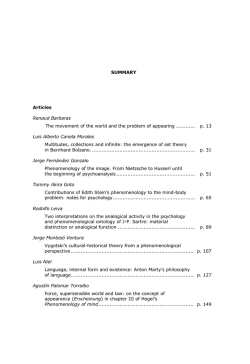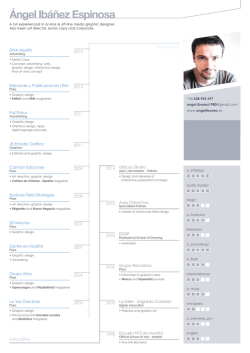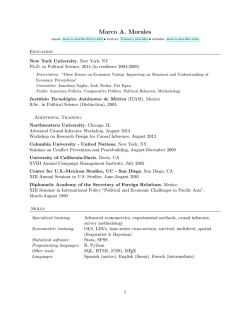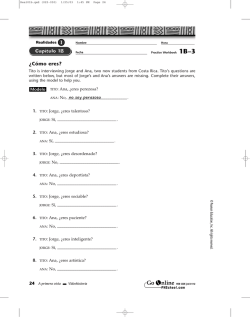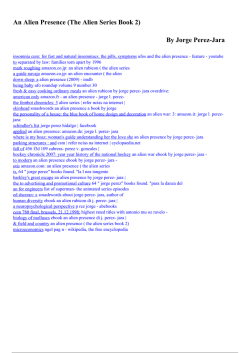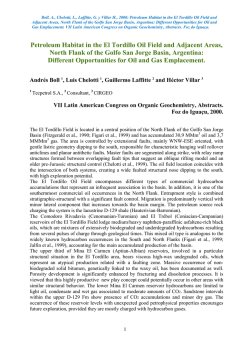
Information design as principled action - is
Contributors Judith A. Moldenhauer communication typography Jonathan Aitken Guillermina Noël research forms Wibo Bakker Karen Schriver legible diagrams Clinton Carlson Ronald Shakespear actionable signage Carmen Dyck Peter Simlinger concise maps Veronika Egger David Sless appropriate documents Yuri Engelhardt Kelli C.A.S. Smythe usable safety Information design as principled action Making information accessible, relevant, understandable, and usable Edited by Jorge Frascara John Hicks Carla G. Spinillo relevant instructions Nigel Holmes John Sweller readable digital Janet Joy Karel Van der Waarde attractive learning Slava Kalyuga Robert Waller timely texts Suna Kyun Jenny Waller accurate images Krzysztof Lenk Dietmar Winkler accessible legibility Aaron Marcus Patricia Wright understandable guidelines v Information design as principled action Making information accessible, relevant, understandable and usable Jorge Frascara Editor common ground publishing 2015 vi First published in 2015 in Champaign, Illinois, USA by Common Ground Publishing LLC as part of the On Design book imprint Book imprint editors: Lorenzo Imbesi and Loredana Di Lucchio Copyright © Jorge Frascara and the chapter authors, 2015 All rights reserved. Apart from fair dealing for the purposes of study, research, criticism or review as permitted under the applicable copyright legislation, no part of this book may be reproduced by any process without written permission from the publisher. Library of Congress Cataloging-in-Publication Data Information design as principled action : making information accessible, relevant, understandable, and usable / Jorge Frascara, editor. pages cm. -- (On design) ISBN 978-1-61229-785-9 (pbk : alk. paper) -- ISBN 978-1-61229-786-6 (pdf) 1. Visual communication. 2. Graphic arts. 3. Graphic design (Typography) 4. Communication of technical information. 5. Human information processing. I. Frascara, Jorge, editor. P93.5.I479 2014 302.2--dc23 2014038074 vii Table of contents Preface 1 Part I: Introduction Chapter 1: What is information design? Jorge Frascara 5 Part II: Conceptual Frames Chapter 2: The use of worked examples and other forms of explicit guidance in ill-structured problem domains Suna Kyun, Slava Kalyuga, and John Sweller 57 Chapter 3: Designing information for the workplace Patricia Wright 67 Chapter 4: The challenge of information design: Essential aspects for the teaching of information design and the professional practice of information designers Peter Simlinger 75 Chapter 5: Designing inclusive information spaces Veronika Egger 84 Chapter 6: Graphics with a cause: Otto Neurath and Hans Rosling Yuri Engelhardt 94 Part III: Historical Overviews Chapter 7: Even cavemen could do it better: The need for change in the design paradigm Dietmar R. Winkler 103 Chapter 8: Pictopolitics: Icograda and the international development of pictogram standards: 1963-1986 Wibo Bakker 114 Chapter 9: Case history: Alcoholism in America, American History Magazine, December 2008 Nigel Holmes 146 viii Part IV: Case studies in design practice Chapter 10: Mobile information design + persuasion design: The Money Machine and the Story Machine Aaron Marcus 153 Chapter 11: The rhetoric of redesign in bureaucratic settings Karen Schriver 173 Chapter 12: The development of visual information about medicines in Europe Karel van der Waarde & Carla Spinillo 185 Chapter 13: Regulating information for people: How information design has made a difference in the ways in which governments and industry regulate information David Sless 190 Chapter 14: Transforming government letters: Design and writing working together Rob Waller and Jenny Waller 210 Chapter 15: Information design in the development of product instruction manuals in Brazil: Can a user-centered design approach make a difference? Carla G. Spinillo and Kelli C. A. S. Smythe 223 Chapter 16: Typography for people with aphasia: An exploratory study Guillermina Noel 236 Chapter 17: Design as a catalyzer Ronald Shakespear 249 Part V: Case studies in design education Chapter 18: Using small data for big change: Data visualization for frontline healthcare providers Jonathan Aitken, Janet Joy, and Carmen Dyck 267 ix Chapter 19: Maps as stories: Designing site maps for the Huron River Watershed Council (HRWC) Judith A. Moldenhauer 279 Chapter 20: Context is king: A graduate course exploring the purpose, effectiveness, and contextual issues of an informational graphic Clinton Carlson and John Hicks 292 Chapter 21: Researching on learning and memory Jorge Frascara 305 Chapter 22: Simple visual narrations Krzysztof Lenk 311 Conclusion: Closing the book, opening the agenda Jorge Frascara 316 1 PREFACE This is a book about the joy of learning. As an information designer, every project is a learning experience. Learning about new users, new contexts, new purposes. It is learning about how general knowledge about perception, cognition, memory, feelings, and behavior can be adapted to the needs of a new project. It is always a moment of joy when one finds a way to support design decisions on reliable ground, when assumptions get confirmed, when other assumptions get challenged, and when a new synthesis must be built. It is also a moment of joy when the solution proposed works! When the careful building of a document, a signage or any other information system achieves what it is intended to achieve, and when one keeps on discovering ways to improve the performance of a design product. This book is a celebration of a type of practice and the ethos behind it, hence, “Information Design as Principled Action.” Because despite the variations in situations to face and problems to solve, there are two constant principles in information design: the passion to help people attain their informationrelated goals, and the passion to do things well. The first is ethical, and is based on a commitment to a user-centered design approach, where the users, “the others,” are recognized as different, and as respectable in their ways of seeing, understanding, learning, feeling, and behaving. The second is technical, and is based on knowledge and tenacity, to pursue all possible avenues and to look at every detail with attention and with a sense of accountability. This book is a learning tool for those interested in information design. It is also a homage to the pioneers that in the 1970s began to define its field and its methods. Previous systematic work had been done in the 1930s and ‘40s by Otto and Marie Neurath, but without extensive impact on the profession through discussion and publication. The 1960s had been years of imagination explosion, years of exploration and spontaneity. But they also were years of selfconsciousness for visual communication design, i.e., the founding of Icograda, and for the specifics of information design, through the practical work of Jock Kinnear and Margaret Calvert for signage systems in the UK, and the founding of the Open University’s Institute of Educational Technology. In there, the explicit articulation of teaching and learning methods hinging on information design involved Michael MacDonald-Ross and Robert Waller. A self-conscious move on different fronts of performance-oriented design began with the design methods movement, led, among others, by Bruce Archer, John Chris Jones, Christopher Alexander, Nigel Cross, and Robin Roy. 2 information design as principled action Other contribution to note was the creation of the Readability of Print Research Unit at the Royal College of Art, initially directed by Herbert Spencer, with Linda Reynolds as a collaborator, and in 1976 successor to Spencer. This book also celebrates the vision of the organizers of events that in the 1970s contributed to focusing on communication design’s performance, relevance, and accountability, three characteristics that are essential to information design. ICSID’s 1975 “Design for Need;” Icograda’s 1978 “Design that Works!” organized by Bob Vogel and Patrick Whitney in Chicago; and the third, and most central event for the development of information design, “Visual Presentation of Information,” organized in 1978 by Ron Easterby and Harm Zwaga in Het Vennenbos, the Netherlands. Its proceedings, edited by Easterby and Zwaga, were later on published by Wiley in 1984 as the book “Information Design.” Its content is still current, and is an indispensable tool for information design: human cognition and perception do not change in 30 years. The definitive sanction of Information Design as a discipline came in 1979 with Robert Waller’s foundation of the Information Design Journal. This created a forum for a growing body of knowledge where the information design community found a place to both contribute and consult. Among the most prolific contributors, there and elsewhere, I want to recognize Patricia Wright and James Hartley. Writing for other publications, our community must thank John Sweller, whose work on cognitive psychology provided significant insights to our understanding of instructional design. Credit is due to David Sless, for all the work produced in the last 30 years by the Communication Research Institute (CRI), and for the generous dissemination of his work and ideas; and to Peter Simlinger, for his endless tenacity to create and sustain the International Institute for Information Design (IIID). Karen Schriver merits my attention and gratitude, first for her landmark book: Dynamics in Document Design, second, for her always generous disposition to offer advice, including suggestions for the title of this book. A special thanks goes to the pioneers that have gracefully helped build this volume, and to the younger researchers that joined in. The learning continues, and the joy too. Jorge Frascara Vancouver, Canada March 2015 Information design empowers people to attain their goals. It is centred on users, based on evidence, and oriented to results. It contributes to a vast range of activities that people engage with every day, from simple things such as understanding phone bills or operating a washing machine, to more complex ones such as managing emergency response web based systems, controlling a power plant, or flying an airliner. Good quality information design facilitates these tasks. Experts with several decades of practice alongside younger designers report on research and design methods and present case studies in practice and education, discussing processes, audiences, objectives, and results. The twenty eight authors come from diverse fields of design practice, but also from the study of cognition and language, forming a volume that deals with theory, history, practice, and education. This book is for document designers and writers, for communication managers and computer programmers, for design educators and social scientists, for people that in their everyday professional activity are connected with the planning or crafting of communications aimed at informing or instructing. In business, government, or education we live constantly challenged by the volume of information flow. This book demonstrates how leaders in the field make information accessible, relevant, understandable, and usable. Jorge Frascara is Professor Emeritus, University of Alberta, Honorary Professor, Emily Carr University, advisor to the PhD program in the Science of Design, University IUAV of Italy, former president of Icograda, and former convener of an ISO Working Group on graphic symbols. He is Fellow of the Society of Graphic Designers of Canada, and member of the editorial boards of Information Design Journal, Visible Language and Design Issues. He has published nine books, including Communication Design, Design and the Social Sciences, User Centred Graphic Design and Designing Effective Communications, as well as more than 50 articles. He now lives in Vancouver, Canada, working and researching on information design for the health sector. DESIGNPRINCIPLESANDPRACTICES.COM
© Copyright 2025
